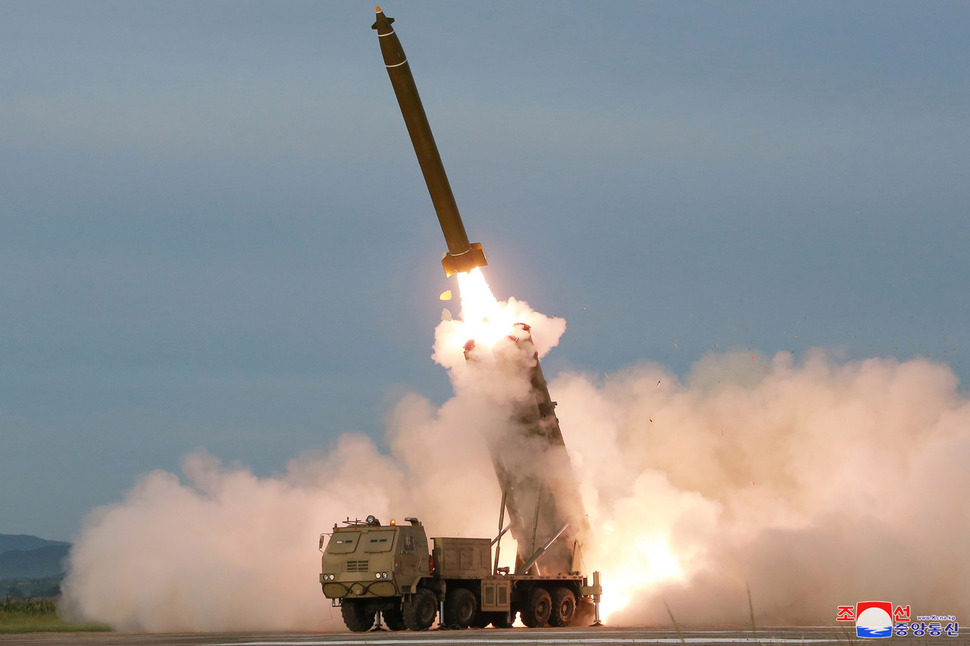 |
|
North Korea test launches newly developed short-range projectiles on Aug. 24.
|
S. Korean JCS identifies projectiles as short-range missiles
North Korean leader directed a “test firing of a newly developed extra-large multiple rocket launcher,” the Rodong Sinmun newspaper reported on the front and second pages of its Aug. 25 edition in a piece that included 18 photographs. The date Aug. 25 is referred to as “Songun (Military First) Day” in North Korea. On Jul. 31 and Aug. 2, North Korea announced that it had “test-fired a newly developed super-large multiple rocket launcher,” but this marks the first time it has referred to test-launching an “super-large multiple rocket launcher.” The Rodong Sinmun praised it as “another Juche weapon without parallel in the world” and “our model of super-large multiple rocket launcher, the world’s strongest.” On Aug. 24, the South Korean Joint Chiefs of Staff (JCS) reported that two “unidentified projectiles believed to be short-range ballistic missiles” had been fired toward the East Sea by North Korea from the area around Sondok, South Hamgyong Province. At a National Security Council (NCS) standing committee meeting at 8:30 am that day presided over by National Security Office Director Chung Eui-yong, the administration expressed “profound concern about North Korea continuing to launch short-range projectiles even after the end of the South Korea-US joint command post exercises it had been denouncing” and called for Pyongyang to “stop engaging in actions that raise tensions.” While directing the test firing, Kim stressed that “we must continue pressing more forcefully forward with the development of our own model of strategic tactical weapons to suppress and crush the intensifying military threat and pressure offensive by hostile forces,” the Rodong Sinmun reported. Stating that the “accurate attainment of planned indicators by all tactical and technical features was tested,” the newspaper said that the “Comrade Supreme Leader [Kim] was unable to contain his delight.” Kim Yo-jong, the first vice director of Workers’ Party of Korea Propaganda and Agitation Department, was also shown in a photograph of the test-firing published in the Rodong Sinmun. The Rodong Sinmun’s report was focused on underscoring and praising Kim’s dedication in “traveling to the distant sea early in the morning” and sharing his praise of young defense scientists for “devising and designing [the technology] purely in their own heads and succeeding in one attempt.” “What pleases me most of all is the training of young and outstanding human resource units who will be responsible for great strides in an autonomous defense industry,” Kim was quoted as saying. “They are precious jewels and assets of the country that I would not trade for all the world,” he said. His remarks indicate that the aims of the test-firing included developing new weapons to overcome North Korea’s inferiority in conventional military strength while assuaging internal discontent and unrest over the lack of progress in North Korea-US and inter-Korean relations. The report did not include any statements of opinion from Kim directed specifically at South Korea or the US. But his remarks about the North’s “success three years ago today with one of the world’s few strategic submarine ballistic missile underwater test launches” recalled a previous submarine-launched ballistic missile (SLBM) test launch on Aug. 24, 2016. Washington does not make big issue of short-range projectiles Coming after the Aug. 20 conclusion of South Korea-US joint command post exercises, the latest test launch appeared to contradict US President Donald Trump’s remarks on Aug. 10 that Kim had pledged in a letter to stop the test launches once the exercises were over. But in comments to reporters on the evening of Aug. 23 prior to departing the White House to attend the G7 Summit, Trump insisted Kim had not violated his pledge. “We never restricted short-range missiles,” he said, suggesting that Washington does not intend to make an issue of the matter. The test firing is a continuation of the message shared recently by North Korea in an Aug. 22 Foreign Ministry’s spokesperson’s statement insisting that “dialogue accompanied by military threats is of no interest to us,” as well as an Aug. 23 statement by Foreign Minister Ri Yong-ho criticizing US Secretary of State Mike Pompeo as an “obstructor who merely casts a pall on the future of North Korea-US negotiations” and stressing that Pyongyang is “fully prepared for both dialogue and confrontation.” On Aug. 24, Pyongyang had a “personal commentary” published by the Korean Central News Agency (KCNA) with the message that North Korea does “not have a lingering attachment on sanctions relief” and “will never barter the strategic security of the country for the sanctions relief.” Its message suggests it will not readily agree to an early resumption of working-level talks with the US as Seoul and Washington have urged, as it continues for some time in a battle to seize the upper hand in the agenda for a third North Korea-US summit. So continues an untidy stalemate situation that is neither negotiation nor confrontation. By Lee Je-hun, senior staff writer Please direct comments or questions to [english@hani.co.kr]






